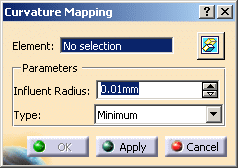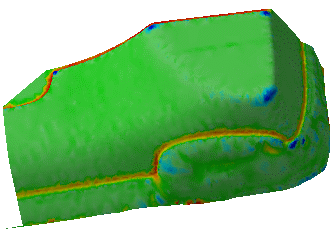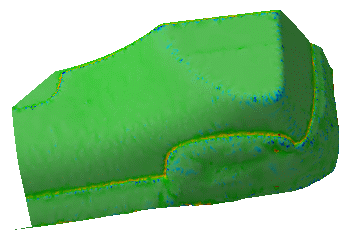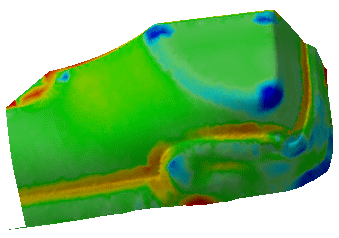
|
This task will show you how to create an editable and
associative curvature mapping on any mesh, e.g. to help you select iso-curvature
points. There are five
curvatures:
- Maximum,
- Minimum,
- Mean,
- Gaussian,
- Absolute.
The geometric construction of the maximum and minimum
curvatures is the following:
let be a plane containing the normal to the surface in a given point.
This plane cuts the surface along a curve that has a given curvature in this
point.
If this plane rotates around the normal, the curvatures of the curves
intersecting
the surface will vary between two utmost values.
These two values are the maximum (KM) and the minimum (Km) curvatures.
The mean curvature is equal to (KM+Km)/2.
The utmost values appear where the surface is the most warped.
The mean curvature is largely used to detect irregularities on the surface.
A minimal surface is characterized by a null mean curvature.
The gaussian curvature is equal to KM.Km.
It describes the local shape of a surface in one point:
- if it is positive, the point is elliptic,
i.e. the surface has locally the shape of an ellipsoid around that point,
- if it is negative, the surface is hyperbolic in this points,
i.e. the local shape is a horse saddle,
- it it is null, the surface is parabolic in this point,
i.e. one of the maximum or minimum curvatures is null in this point.
The cone and the cylinder are two surfaces where all points are parabolic.
The absolute curvature is equal to |KM|+|Km|.
It is used to detect the surface areas where the surface is locally almost
flat
(the absolute curvature is almost null). |
 |
-
Click Curvature Mapping
 . .
The Curvature Mapping dialog box is displayed.

-
Select Polygon as the Element to
process.
The mesh may not be non-manifold and must contain one single cell.
Click
 to hide the input element.
to hide the input element.
-
An Influent Radius
is proposed.
By default, it is 1/100 of the diagonal of the bounding box. In this case
2.956mm:
 For each vertex, this radius defines a sphere centered on this vertex.
All vertices and edges inside this sphere influence the resulting
curvature value at this vertex.
If the Influent Radius is small, the
result will be noisy,

if it is large, the curvature will be smoothed.

-
Select the type of curvature to apply from
the drop-down list:

-
Click Apply. The curvature mapping is
displayed:

-
Click OK to validate and exit the dialog box.
A feature Curvature Mapping.x is created in the specification tree.
If necessary, double-click its name to edit it.
|